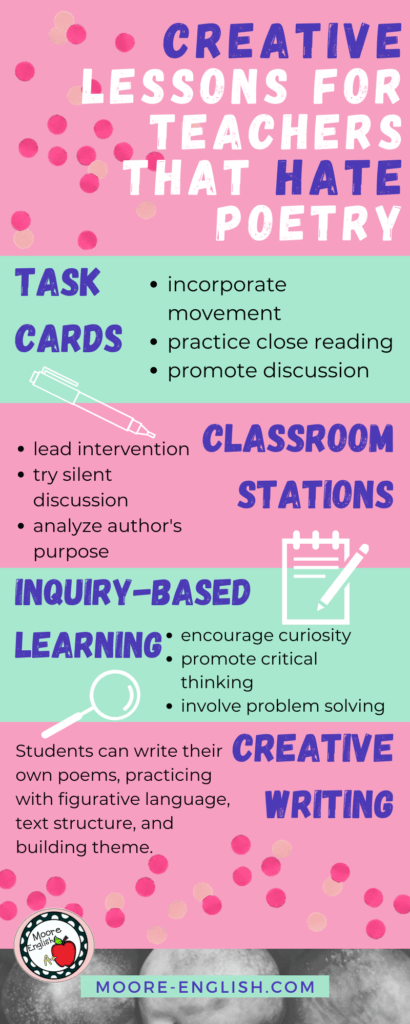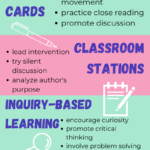Let me confess: I don’t love every piece of literature I teach. A student performance of “The Yellow Wall-paper” left an indelible mark.
For a period in my career, I came to hate poetry. Students never knew how to handle it, I couldn’t package the lessons correctly, and I never knew quite what I was teaching with poetry.
Overtime, I have worked through these struggles. I have developed a system that helps all students approach poetry. Similarly, I have learned how to make the most of teaching poetry. And my lesson planning skills have evolved so I always know the purpose of a lesson.
Now, instead of hating it, teaching poetry is my classroom superpower! Today, I want to share 5 creative lessons for teachers that hate poetry!
This post this post may contain affiliate links. Please read the Terms of Use.
If you hate poetry, put it in motion!
When I am trying to engage students in a lesson, adding movement is one of my go-to strategies. Getting students up and moving with purpose can help make a lesson meaningful and can help students better connect to material. With this in mind, here are some ideas to help put poetry in motion!
- Firstly, task cards are a great way to help students interact with poetry in a meaningful way.
- Secondly, using classroom stations can be a good opportunity to incorporate movement. Of course, task cards can be their own station. Other stations could include close reading, analyzing author’s purpose, enrichment/intervention, guided reading, and/or silent discussion.
- Thirdly, inquiry-based learning is a whole class strategy that emphasizes cycles of think-pair-share or jigsaw grouping. In this post, I share my lesson plan for using inquiry-based learning to teach Shakespearean sonnets!
If you hate poetry, put it in action!
Putting poetry in motion is a great way to eliminate poetry hate. Adding action is another option for helping not kill a student’s love of poetry. In this case, action is all about student ownership and creation! Giving students a chance to write and create their own poetry is a great opportunity for eliminating poetry hate!

As a younger teacher, sometimes felt guilty about giving students time for creative writing. However, creative writing is a good way to emphasize text structure, author’s craft, word choice, and theme! When students write their own literature, they have to engage all of their literary elements with purpose and intention.
In terms of poetry, I find sonnets and concrete poems to be some of the best options. These two types of poetry provide students with the structure to be successful while still giving them a creative outlet.
Firstly, I like to give students a clear model of a concrete poem. The concrete poem I most often use with my students is “Easter Wings” by George Herbert. However, I also include concrete poetry in my lessons on “Home Court” by Jose Olivarez and “Social Distancing” by Juan Felipe Herrera.
Similarly, when dealing with sonnets, I also like to give students an example, usually the Shakespearean sonnets included in Crash Course Literature. However, I sometimes also use Petrarchan sonnets such as “Before a Painting” by James Weldon Johnson.
Regardless of what sonnet structure I teach, I always want students to have a rubric for their final product, which is when I use this free, editable Shakespearean sonnet rubric!
How do you teach poetry?
Since it’s National Poetry Month, you probably have poetry on your mind even if you hate poetry! What are your favorite poems to teach? How do you invite students to enter the world of a poem even if you hate poetry? Let us know in the comments!


























